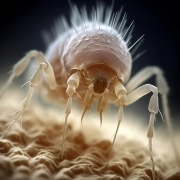Dust Mites: They are everywhere!
Dust mites (Dermatophagoides farinae) are often called spider mites. These tiny arachnids are off-white in color, shaped like a globe, and can have an average life span of a month and are known to live up to 3 months!
 Because dust mites are so small, the human eye alone cannot detect them; To see dust mites, you’ll need a basic microscope. Female dust mites are larger than their male counterparts and can lay between 1 to three eggs daily.
Because dust mites are so small, the human eye alone cannot detect them; To see dust mites, you’ll need a basic microscope. Female dust mites are larger than their male counterparts and can lay between 1 to three eggs daily.
According to a controversial article by William F. Lyon* written for the Extension Service at Ohio State University, a typical used mattress may have anywhere from 100,000 to 10 million mites inside!
It goes on to state that 10% of the weight in a pillow that is two years old can be composed of dead mites and their waste. One more disturbing finding was that when you open your shades and see that beam of light with many floating objects, eighty percent are flakes from your skin!
In as little as a month, a dust mite can reach adulthood and thrive best in damp material, such as towels, clothes, or a mattress.
Dust mites love dead skin, and some of the best repositories of dead skin are bed covers, blankets, and anything made of cloth, dust, and more. Higher than normal humidity levels can also contribute to dust mites.
Dust Mite Causing Skin Problems
Dust mites are commonly thought of as causing dermatitis, asthma, and rhinitis. For example, if you sleep on a mattress containing many dust mites, you’ll notice red itchy bumps. These bumps result from your skin reacting to the allergen of the dust mite. Small children are also said to run the risk of asthma if exposed to the feces of dust mites.
Controlling Dust Mites
Dust mites can cause various health problems. While there is no way to completely eliminate dust mites, controlling them can reduce a person’s risk of suffering from the health problems associated with an infestation of dust mites. This article is an overview of measures to control the dust mite population in your home.
While you sleep, dust mites are hiding in your bedding. Several things can be done to reduce the dust mites in your bedding. The simplest solution is to wash bedding such as bedcovers, blankets, and sheets once weekly in hot water.
For pillows, it is recommended that you replace feather and down pillows with synthetic materials as a filling. Alternatively, you can replace your pillow covers with dust-proof zippered ones.
As stated before, washing blankets and other bedding once a week will help control dust mites in your bed. Also, replace wool blankets with cotton or nylon.
One of the more cost-effective ways to control dust mites is to damp dust the plastic mattress cover on your bed. Buying dust-proof zipped mattress covers is an alternative method to prevent a dust mite infestation. Research also shows that covering your mattress with fitted sheets helps slow the accumulation of skin scales; this is a low-cost alternative to dust-proof mattress covers.
Carpeting is another breeding ground for dust mites, but there is help. Vacuuming carpeting areas regularly helps control dust mite populations. A vacuum is also recommended to be equipped with a HEPA filter when vacuuming the carpet because the filter will trap allergens. You can also replace carpet with vinyl flooring.
Dust mites thrive in high humidity conditions, but this can be controlled through de-humidifiers and air conditioners. To remove dust mite allergen from the air, researchers suggest an air filtration system, especially one that uses a HEPA filter.
Detecting Dust Mites
Dust mites could be a source of allergens in your home, and detecting dust mites is the first step to controlling them. We focus on commonly used detection methods for dust mites.
There are several dust mite detection kits commercially available. Several dust mite detection kits measure the presence of dust mite allergens inside samples collected from the entire home. The combined collected samples, with indicator chemical agents, tell the user about the infestation levels in the house.
A person may also detect the presence of dust mites by putting a small amount of dust on the surface of the water and then examining it under 20 times magnification with a microscope. A microscope is needed because dust mites are too small to be seen with the naked eye.
This method requires sufficient technical knowledge and a microscope with the necessary magnification.